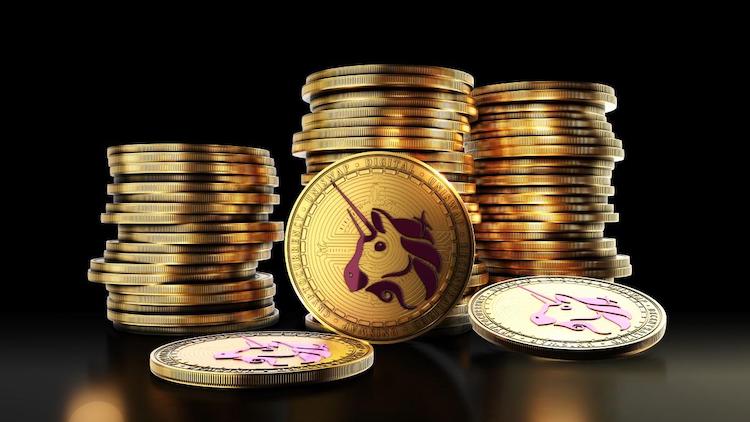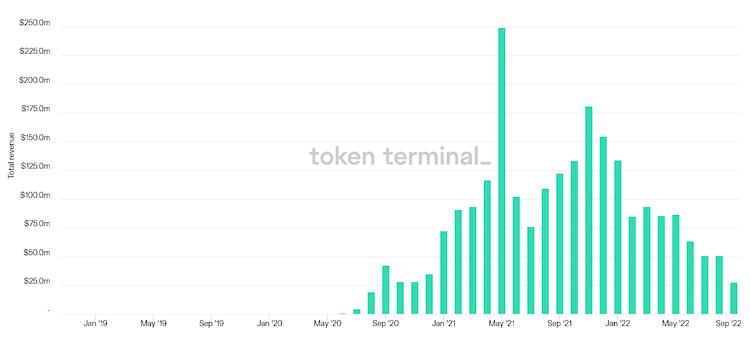
Summary: In 2021, Uniswap reigned as the undisputed leader of the DEX revolution. With no centralized order book, the exchange relied on a smart algorithm to set prices on hundreds of ERC-20 token pairs available on the platform for buyers and sellers.
With low trading fees and a growing userbase, Uniswap was the king of DEXs. But now, the crown seems to be slipping.
What has changed? Is Uniswap’s UNI still a good investment? Who may be next to the throne? Read on to learn the answers to these questions and more.
Uniswap was one of the largest decentralized exchanges in the cryptocurrency arena in 2021, handling the lion’s share of DEX trading volumes.
Traditional centralized exchanges (CEXs) like Coinbase and Binance rely on an order book – a list of all the buyers and sellers for specific security – to set the prices on the exchange.
Decentralized exchanges (DEXs) like Uniswap rely on mathematical formulae to price the assets. This technology is called an automated market maker (AMM), and it removes the need for a middleman to set the prices for the market.
In the history of crypto, Uniswap was a significant step forward.
Where CEXs were slow to add new tokens (they had to carefully vet each one), Uniswap could automatically support any Ethereum-compatible token where there was enough supply and demand. The software-based approach let the company scale quickly.
The original version of the Uniswap protocol was launched on the Ethereum mainnet in November 2018. There have been several incremental upgrades since then:
- Version 1 allowed users to trade between ETH and any ERC-20 tokens.
- Version 2 launched in May 2020 and added new features and functionality like increased decentralization, Flash Swaps, and ERC-20 pools, allowing direct exchange between different Ethereum-based tokens.
- Version 3 launched in May 2021 and improved security and efficiency, with features like concentrated liquidity, range orders, NFTs, and flexible fees.
The native token of the Uniswap protocol is also called Uniswap (UNI). Its stated purpose is to serve as the governance token of the protocol, though our thesis is that investing in UNI is like buying Uniswap “stock.”
UNI was launched without any ICO/token sale in September 2020. Instead, community members, protocol users, and liquidity providers were given free airdrops of the token, up to 400 UNI (worth approx $1500 at the time).
Synthetix founder Kain Warwick called the airdrop a “galaxy brain move,” since it rewarded early users for their loyalty. It was a bit like getting free stock in a company at its IPO, as thanks for being a loyal customer.
The airdrop was another Uniswap innovation that has since been copied by many new crypto projects, and today is expected of any new token launch.

Does Uniswap Have Revenue?
As a decentralized exchange, Uniswap generates revenues for two main parties: the team behind the protocol, and the liquidity providers (LPs).
Uniswap Team Revenues
The protocol is managed by the Uniswap company, formed by founder Hayden Adams. The company has received massive financial backing from prominent investors like Andreessen Horowitz, Paradigm VC, and Union Square Ventures. (The project is not short on funds.)
Beyond available capital reserves, the Uniswap protocol also earns revenues by charging a small fee for every trade executed on the DEX. But the overwhelming majority is paid out to liquidity providers (see below), and the company does not currently run on profits.
Apart from the trading fees, the other main source of value/revenue for the project is its native token, UNI. Although the majority of the tokens were airdropped to community members, liquidity providers, and protocol users on launch, 20% of the UNI supply has been kept in reserve.
The total supply of UNI is 1 billion. At the time of writing, UNI had a price of $6.90, putting the value of the 20% reserve at $1.3 billion, which is set aside for the team behind the Uniswap project. Depending on the coin’s market price, this share can bring in additional revenues.
Uniswap LP Revenues
Anybody with available crypto assets can become a liquidity provider, or LP. A decentralized exchange cannot function without LPs: they make the trades possible. Thus, Uniswap wants to encourage as many people as possible to become LPs.
To understand the revenue potential for being a Uniswap LP, a quick detour to explain how Automated Market Makers work.
In an order book system at a traditional exchange like Binance or Coinbase, we have trading pairs. (For example, BTC/ETH, ADA/DAI, or any other pairing of two currencies.) On these traditional crypto exchanges, a transaction occurs between a buyer and a seller, i.e., peer-to-peer.
However, in an AMM exchange, the counterparty is not one person, but a pool of funds supplied by many different users, with the smart contract setting the price and executing the trade.
This is where LPs enter the equation: the cryptos they lock into Uniswap provide the liquidity to the smart contract. Instead of a buyer and seller, you have a buyer and a liquidity pool. People make up the pool.
In Uniswap, these pools are usually based on token pairs like ETH/BTC or SOL/DAI. To participate in a liquidity pool, you deposit equal amounts of the two tokens in a 50:50 ratio (for example, 50% ETH/50% BTC).
The AMM on Uniswap uses a formula of x * y = k to calculate the pricing of tokens. In the equation, k refers to a pool’s total liquidity and has to remain constant. The other two variables, x and y, refer to the amount of participating tokens.
Since they are so integral to an AMM, liquidity providers are rewarded handsomely by the protocol. The lion’s share of the trading fees charged on the platform goes to the LPs.
In 2021, Uniswap generated over $1 billion in revenues, with the entire amount awarded to the LPs (less the $40 million reserved for the project team). This is more than 99% of the total revenues on the protocol.
It can pay to play in the pool.

The History of Uniswap Revenues
Uniswap started to take off after the launch of v2 in 2020, which allowed users the freedom to trade any ERC-20 token pairs. (Before that, v1 only allowed users to trade ERC-20 tokens against ETH.)
Monthly revenues climbed from $4.8 million in July 2020 to $35 million by December that year. But the real spike in Uniswap revenues occurred in 2021, as v3 upgrades added further efficiency and features.
The protocol gained widespread acceptance, and monthly revenues quickly exceeded $100 million by March 2021. Uniswap hit a new peak in May, with revenues reaching an all-time high of $285 million.
Uniswap revenues declined briefly in Q3 2021 before regaining steam in Q4, rallying to $180 million in November. Since then, revenues have been on a sustained downswing, along with the broader crypto market:

Some context is needed: we are still in the crypto winter of 2022, and cannot see this as a long-term trend with Uniswap, especially without looking at the competition.
Uniswap Revenue vs. Other DEXs
Uniswap remains the top DEX on Ethereum, but several contenders have emerged, providing stiff competition for the throne:
SushiSwap and PancakeSwap: Both are clones of Uniswap, built using the latter’s open-source source code and offering similar features and similar/lower fees as a competitive advantage.
Compound: Launched in 2017, this is a specialized DEX that creates tokens for assets locked on the platform. The tokens allow users to earn interest while retaining the freedom to transfer and use the assets on other platforms.
Curve Finance: Another specialized DEX, focused exclusively on stablecoins like USDT, USDC, DAI, and TUSD. User can stake their stablecoins in liquidity pools or swap between different coins on the trading platform.
dYdX: Another DEX launched in 2017, dYdX gives additional options to users in the form of derivative trading. It overtook Uniswap as the top DEX in terms of trading volume in September 2021.
Let’s compare Uniswap’s revenues against the contenders:

It is undeniable that the rise of clones like PancakeSwap and SushiSwap has eaten a chunk out of Uniswap’s business. Together, these clone DEXs accrued $1.5 billion in revenues, despite launching after Uniswap.
And dYdX has been steadily eating away at the market share of Uniswap since 2021. With the advantage of an order book, derivative trading, and a massive airdrop of the dYdX token, the protocol has taken the top spot of DEX tables with $1.2 billion in trading volumes (daily).
Here is a quick look at the recent DEX rankings:
| DEX | 24h Volume | Market Share | No. of Markets | Type | Launch Date |
| dYdX | $1.2 billion | 0.0016% | 10 | Orderbook | April 2019 |
| Uniswap V3 | $1.01 billion | 0.0013% | 578 | AMM | May 2021 |
| Kine Protocol | $268 million | 0.0004% | 16 | Peer-to-Pool | March 2021 |
| Pancakeswap V2 | $225 million | 0.0003% | 3844 | AMM | April 2021 |
| Honeyswap | $142 million | 0.0002% | 70 | AMM | July 2020 |
Source: CoinMarketCap
Why Uniswap is Important for Investors
Uniswap is the most successful DEX based on the AMM model. Moreover, if it maintains high revenues and stability, it’s the proof of concept that a crypto exchange can work, without a centralized order book or market maker.
The entire concept of blockchain is based on decentralization: trusted transactions on a transparent yet highly secure network. Uniswap brings that vision to the crypto exchange market — like handling your money yourself.
Conversely, mainstream crypto exchanges use centralized architectures to provide a better user experience and more user safety — like trusting a broker or banker to handle your money for you.
2022 has been tough for everyone in the crypto market, but if revenues keep falling on AMMs, it could be a sign for investors to look at other more profitable alternatives for staking liquidity.
Investor Takeaway
Uniswap faces an uncertain future. Though it still has a huge userbase, it is losing market share to competing DEXs that do not have the AMM model. Many LPs face an uphill battle to retain profits in AMMs due to “impermanent loss.”
Still, Uniswap has a history of innovation, and delivering on significant protocol upgrades. Uniswap ships. It is also far easier to for the average user to understand and use than tech-heavy sites like dYdX.
With the rise of knockoffs and non-AMM alternatives, Uniswap has its work cut out: it must continue to innovate, adding new features and improving its user experience, two areas where it has traditionally performed well.
Of course, much will also depend on the future trajectory of the crypto market. It’s still too early to write out Uniswap from the world of DEXs, which is why we continue to hold UNI as part of our Future Winners Portfolio.
FAQs
Is Uniswap Worth Investing In?
The Ethereum blockchain is the most popular and vibrant crypto ecosystem in the world. It is also likely to receive significant upgrades to efficiency, gas fees, and transaction times over the next several years, making it hard for other Layer 1 chains to overtake it.
As the pre-eminent decentralized exchange on Ethereum, with access to over 578 trading pairs, Uniswap still has a lot to offer investors interested in staking their assets in liquidity pools.
Our investment thesis is that buying and holding UNI is like a long-term investment in the Uniswap company. Despite the challenges listed above, we believe in Uniswap’s ability to execute, and currently have the token as a part of our Future Winners Portfolio.
How does Uniswap make money?
Uniswap makes money by charging a 0.3% fee for each trade on the platform. Most of this is paid out as a reward to liquidity providers. The company also earns revenue via the governance token UNI, which can appreciate in value with changes in the crypto markets.
However, in the present scenario, over 50% of LPs on Uniswap are losing money due to impermanent loss [read our guide here]. In a highly volatile crypto environment, loss in the value of a token is not compensated by the fees of a transaction on the DEX.
This causes a loss in dollar value to investors on the platform. In the future, this may change with an improved algorithm. But as long as they fail to address impermanent loss, Uniswap will remain a sub-optimal investment option for liquidity providers.
Should you trade on Uniswap?
DEXs like Uniswap require some technical expertise: you must own a crypto wallet like Metamask, and understand how to navigate gas fees. In addition, the interface may not provide much hand-holding, unlike centralized exchanges. With those caveats, if you want to buy or sell any ERC-20 tokens, Uniswap is one of the best DEXs on the market.
This news is republished from another source. You can check the original article here

Be the first to comment